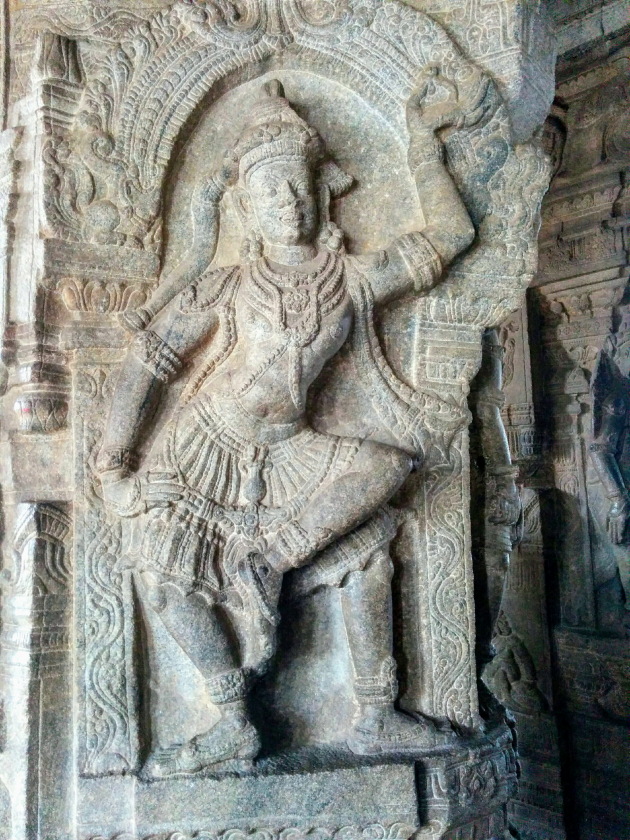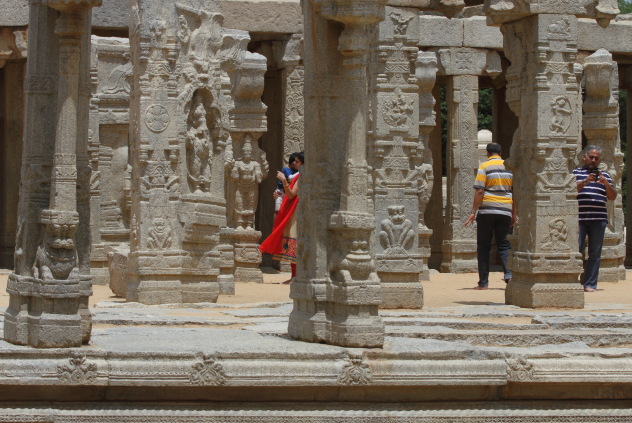Lepakshi: Off Beat Temple Day Trip from Bangalore

When it comes to the temple riches of the Vijayanagara empire, there is no better example than Hampi, whose mystic charms and rich history are known the world over. But, there do exist a few temples from the empire that share the same exotic quotient and that stand in full glory. One such temple built by the governors of the Vijayanagara empire in the 16th century is the Veerabhadra temple that is built in the shape of a tortoise at Lepakshi, Andhra Pradesh. And given that this temple is only 120 kms from Bangalore, it offers the interesting prospect of an off-beat temple day trip from Bangalore either during the week or the weekend.

Now, you might be wondering why I am recommending a small temple so much. Even though it is small, it packs quite a punch with its many beautifully decorated and designed elements. The one that catches everyone’s attention and that is the highlight of a visit to this temple is the hanging pillar. A beautiful work of architecture, this massive stone pillar hangs in thin air while being surrounded by other gorgeously carved pillars. The other aspect is the very large Nandi bull that is carved out of a single piece of stone and that is considered as one of the largest of its type in the world. And then there is the pillar garden, the inner sanctum housing three main Hindu gods, the rock chain, the Vastu Purusha, the Lepakshi Saree designs and so much more.

Once you have parked your vehicle and make your way up to the temple entrance through the maze of shops on either side, you might be greeted by the many monkeys that have made Lepakshi’s Veerabhadra temple their home. So far from the outside, the temple looks simple and like any other temple of South India, but once you climb those black granite steps and enter the first chamber of the temple with all its pillars, carvings and sculptures, that is when the true beauty of this temple dawns on you.

Considered by Skanda Purana as one of the divyashetras, the Lepakshi Veerabhadra temple is an important pilgrimage site of Lord Shiva. As you make your way straight to the shrines of Shiva, Vishnu and Veerabhadra (fearsome form of Lord Shiva), you cannot stop noticing the well preserved fresco paintings from the Ramayana, Mahabharata and the Puranas along with the giant sculptures and the jewellery and saree designs on the pillars.

The temple that you have just entered can be broken down into three parts: the assembly hall or mukha mantapa or Natya mantapa where you are standing, the Ardha mantapa and finally the Garbhagriha or the sanctum sanctorum. While the Mukha Mantapa is made up of beautifully decorated pillars, it is the Ardha Mantapa and its fresco paintings that keep you spell bound.

One of the Ardha Mantapa fresco paintings is said to Asia’s largest and it has the frescoes of 14 Avatars of Lord Shiva. This fresco painting is so beautiful that you can almost always see guides pointing their flashlights here and explaining the different Avatars to the visitors. While this fresco painting adorns the top, the bottom is covered by stunning amazes of divine beings, saints, musicians, dancers and Avatars of Shiva.

If you see figurines of Goddess Ganga and Yamuna flanking the entrance, that means you are entering the garbhagriha or the sanctum sanctorum where the presiding deity is a large statue of Lord Veerabhadra, fully decorated and armed with skulls. As you walk clockwise in this chamber, you will also see a linga installed by Sage Agasthya here, the sanctum for Lord Shiva and a statue of Goddess Parvathi as you exit the garbhagriha. If you look up, you will notice paintings of the regally dressed builders of the temple.
All of this carving, painting, sculpting and design magic lies in a very short area. But, this is only a small portion of the temple. As you re-enter the Mukha Mantapa with the pillars and make your way clock-wise around the temple, you will notice that this temple has been indeed built on a rock mountain. And as you keep going forward you will come across another beautiful part of this temple, which is the huge granite carving of a coiled multi-hooded serpent providing an umbrella like cover to a Shiva Linga.

Along this shiva linga, you will see a row of pillars, which might have been a place to house devotees. Right behind the Shiva Linga is a big rock carving of Lord Ganesha and once you cross it, you will come to the pillar garden of the temple, easily the most photogenic parts of the temple. This pillar garden looks like it was either the prototyping ground for the main temple or the remains of the pillars from the main temple were kept here. Either ways, one can enjoy them in different shades and glows as the light traverses across and on top of them unlike the pillars in the main temple that are housed in total shade.

These pillars, similar to the pillars of the main temple, are made up of decorated Lepakshi saree designs, beautiful sculptures of figurines, dancers, gods, jewels and much more. I would totally recommend spending a lot of time in this pillar garden and may be exploring it from all angles.

The exploration of the temple is not complete even as you finish the clock-wise circle of the temple and find yourself outside the temple amidst the maze of shops. The huge granite monolith Nandi bull bedecked with garlands and bells and that faces the statue of the serpent in the precincts of the temple at about 200 metres from the temple is another of the gems surrounding this temple. This Nandi monolith is considered as one of the largest of its kind in the world.

Finally, make your way to the top of the hill that overlooks the temple. Not only can you see the tortoise shape of this temple, but you can soak in the entire landscape of this region. The best time to climb up this hill is either during sunrise or sunset.
 As you can see, this off-beat temple location from Bangalore packs quite a punch of cultural riches with its many magical design elements. Hope you enjoy this Vijayanagara temple beauty as much as I did!
As you can see, this off-beat temple location from Bangalore packs quite a punch of cultural riches with its many magical design elements. Hope you enjoy this Vijayanagara temple beauty as much as I did!

How to reach here:

The nearest airport is Bangalore, which is well connected by both domestic and international flights. Hindupur is the closest railway station and from there you can catch a bus, autorickshaw or taxi to the Lepakshi temple.

By road, Lepakshi is located about 120 kms from Bangalore. One can either take the 4 lane Hyderabad National Highway NH 44 to Kodikonda and then turn left to Lepakshi or you can take the quieter alternate route of NH 9 via Yelahanka –> Doddaballpur –> Gauribidanur –> Hindupur and then turn right towards Lepakshi.



































